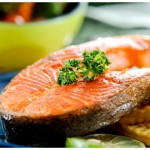February is American Heart Month – a very important time of year – especially for those of us who have been affected by heart disease personally. When I was 17 years old I lost my father to a heart attack. I was devastated. And, as it turns out, it runs in my family. I also lost my grandfather to a heart condition. According to the Centers for Disease Control and Prevention, heart disease is the leading cause of death today for both men and women. I like to think that because I eat right and exercise regularly that I am somehow “exempt.” But, of course February is a great reminder that we all need to stay on top of our heart health, get our heads out of the sand and get our cardiovascular systems moving.
Everyone can take steps to lower their risk of heart disease and heart attack by eating more wholesome foods and consuming less highly saturated fats, which raise blood cholesterol levels. In addition, physical inactivity is related to the development of heart disease, which contribute to obesity, high blood pressure, high triglycerides, a low level of HDL (good) cholesterol, and diabetes — other risk factors for heart disease. Regular physical activity can improve those risk factors.
So what can you do today? Here are three things that you may not know, which will impact your risk for heart disease!
3 Habits You Should Take To Heart:
1. Make small changes to what you eat. What you put into your body can have a large effect on your heart and your health. If you want to improve the health of your heart, make the following changes to your diet:
a. Cut the intake of salt. The Institute of Medicine recommends less than 1,500 mg of sodium per day for those over 50 or with high blood pressure… Make sure you read the labels.
b. Get adventurous with your whole grains. A Nurses’ Health study showed a 50 percent decrease in heart disease among those who ate at least 3 servings of whole grains a day. My favorites are oatmeal, quinoa, and barley. Oatmeal is not just for breakfast, if your craving an afternoon snack try the 3 Sisters Plain Grain pouches with some walnuts or raisons and a dash of almond milk.
c. Start your day with a heart healthy shake. An Interheart study showed a 30 percent decrease in heart disease among those who ate more fruits and vegetables each day. An easy way to do that is with a protein shake made with fresh or frozen fruit. I make one of these every morning.
Heart Healthy Shake
1. 8oz almond milk
2. ½ cup frozen mixed berries (raspberries, blueberries)
3. 1 tablespoon of Nano Greens
4. teaspoon of flaxseed oild. Eat foods high in Omega-3 fatty acids. How can you get the best food with omega-3 fatty acids? Go Fishing!
2. Go fishing with the 6 best & cut bait with the 6 worst! The American Heart Association recommends eating certain types of fish at least twice a week (see below list). Why? Because fatty fish are high in omega-3 fatty acids, which may work wonders on your cardiovascular system and lower your cholesterol, reduce inflammation, improve arthritis, and even improve learning ability. In October 2009, Seafood Watch, a program run by the Monterey Bay Aquarium in California, combined data from leading health organizations and environmental groups to come up with the list “Super Green: Best of the Best” Seafood. To make the list fish had to a) be low in contaminants b) high in omega-3s and c) come from a sustainable fishery. Look for the MSC Blue eco label for a more conscious choice.
The Six Best Fish Include:
- Albacore tuna
- Farmed Mussels & Oysters
- Pink Shrimp from Oregon
- Farmed Rainbow Trout
- Salmon (wild-caught, Alaska) – strict regulations and quotas ensure that Alaskan salmon are both healthier and more sustainable.
- Sardines, Pacific (wild-caught) – naturally high in vitamin D and 3oz. of sardines contain 1,950mg of omega-3s!
The Six Worst Fish include:
- Bluefin Tuna
- Chilean Sea Bass
- Groupers
- Monkfish
- Orange Roughy
- Salmon (farmed)
3. Rev it up. It probably goes without saying that one of the best things you can do for your cardiovascular system is aerobic exercise. But, surprisingly, resistance training has a unique set of heart benefits, too. A study at the Journal of Strength and Conditioning Research revealed that strength training may lead to a longer-lasting drop in blood pressure after exercise than aerobic exercise alone. My “Stay Firm Upper & Lower Body” Kits offer a complete solution: Not only will they help you get stronger, fitter and more toned – but they also serve as a complete cardiovascular system tune-up.
I’m also including a delicious and easy-to-make salmon recipe that won’t take more than 20 minutes to make, including cooking time. So, enjoy!









I noticed on your list of the worst fish was Orange Roughy… What’s wrong with that fish? I love the taste of it and I always thought is was good for you.